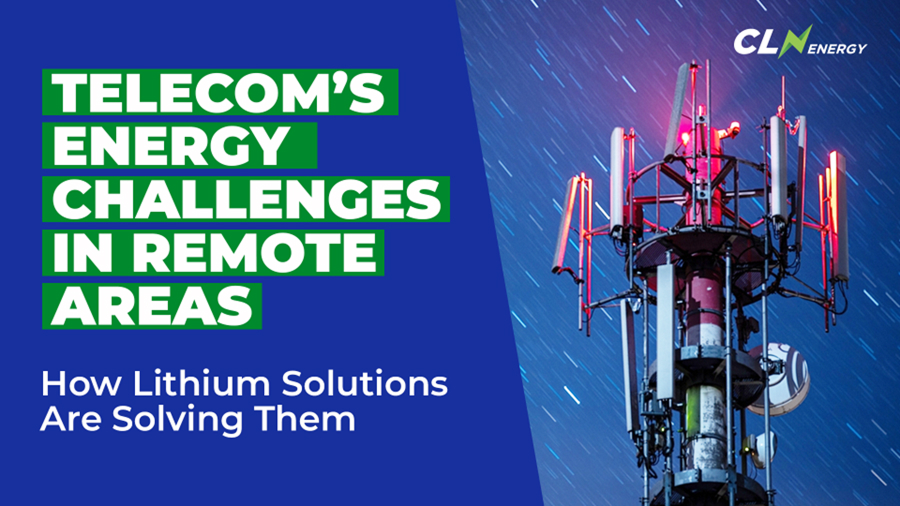India’s telecom sector is booming — but powering telecom towers in remote and challenging locations is a major hurdle. From dense forests and high mountains to arid deserts, these towers require reliable, efficient, and durable energy sources to keep India connected. Traditional power solutions have struggled with inconsistent grid access, extreme weather, and maintenance difficulties. Enter lithium-ion battery technology, a game-changing solution designed to overcome these challenges and enable the telecom industry’s rapid growth.
This blog explores the key energy challenges telecom operators face in remote areas, the advantages of lithium-ion batteries, and how CLN Energy is driving advancements in lithium battery solutions tailored for telecom infrastructure.
1. The Energy Challenges for Telecom Towers in Remote Locations
a. Unreliable Grid Connectivity
- Many telecom towers are situated far from urban centers where grid infrastructure is weak or absent.
- Grid outages and voltage fluctuations are common, leading to interruptions in service.
- Backup power systems like diesel generators increase operational costs and environmental pollution.
b. Extreme Climatic Conditions
- Telecom towers in India face temperatures ranging from sub-zero in the Himalayas to over 50°C in deserts like Rajasthan.
- High humidity, dust, and monsoon rains further challenge equipment durability.
- Traditional lead-acid batteries degrade quickly under such conditions, causing frequent replacements and downtime.
c. Logistical and Maintenance Constraints
- Remote locations make regular maintenance visits costly and time-consuming.
- Fuel supply for diesel generators can be irregular, adding to operational risks.
- Heavy and bulky batteries add to transportation and installation difficulties.
d. Space Limitations and Infrastructure Costs
- Urban and semi-urban towers often have space constraints, limiting the size of battery banks.
- Optimizing energy storage capacity in minimal space is critical for efficient tower operation.
2. Why Lithium-Ion Batteries Are the Ideal Solution for Telecom Energy Needs
a. High Energy Density and Compact Size
- Li-ion batteries provide 3-5 times more energy density compared to traditional lead-acid batteries.
- This compact form factor allows telecom operators to install smaller, lighter battery packs without compromising capacity.
- Space efficiency is especially valuable for urban and rooftop telecom sites.
b. Temperature Resilience and Durability
- Operate efficiently within a wide temperature range: from -20°C to +60°C.
- Superior thermal stability reduces risks of overheating or freezing-related failures.
- More resistant to deep discharges, extending overall battery lifespan up to 5-8 years, compared to 2-3 years for lead-acid.
c. Faster Charging and Lower Maintenance
- Lithium batteries can recharge 2-3 times faster than lead-acid alternatives.
- Require minimal maintenance—no water topping or equalization charging.
- Reduced maintenance means fewer site visits, cutting down operational expenses significantly.
d. Environmentally Friendly and Cost-Effective Long Term
- Longer cycle life reduces the frequency of battery replacement, minimizing electronic waste.
- Compatible with renewable energy sources like solar, enabling sustainable telecom tower operations.
- Lower total cost of ownership over the battery’s lifetime, despite higher upfront costs.
3. Real-World Impact: How Lithium Batteries Improve Telecom Infrastructure
a. Improved Network Reliability and Uptime
- Stable power supply prevents dropped calls and service disruptions.
- Longer battery life ensures telecom towers stay operational during prolonged outages.
b. Cost Savings Over Time
- Reduced fuel consumption and generator run-time lower operational costs.
- Minimal maintenance and replacement costs decrease overall expenses.
c. Enabling Remote Area Connectivity
- Lithium solutions empower telecom providers to extend coverage into previously unreachable areas.
- This supports national digital inclusion initiatives and boosts rural economic growth.
4. Case Study: Lithium Batteries in Indian Telecom Sector
According to industry reports:
1. The Indian telecom sector’s battery market is expected to grow at a CAGR of over 15% by 2030, primarily driven by lithium-ion adoption.
2. Major telecom operators have started replacing lead-acid batteries with lithium-ion solutions at key tower sites to improve reliability and cut carbon emissions.
3. Integration with solar power systems is becoming standard, facilitating green energy use for off-grid towers.
5. CLN Energy: Enabling Next-Gen Lithium-Ion Solutions for Telecom
a. Tailored for Telecom Operations
- CLN Energy’s batteries come with customized Battery Management Systems (BMS) ensuring:
- Real-time monitoring of battery health and performance.
- Predictive maintenance alerts minimizing downtime.
- Enhanced safety mechanisms preventing thermal runaway and faults.
b. Robust and Scalable Solutions
- Batteries designed for easy integration with existing telecom power systems.
- Modular designs allowing operators to scale capacity based on site-specific energy demands.
- High tolerance to extreme temperatures and environmental conditions ensures long-term reliability.
c. Supporting Telecom’s Digital Expansion
- By providing durable, high-performance energy storage, CLN Energy enables telecom companies to:
- Expand coverage to remote and undeserved regions.
- Improve network resilience and uptime.
- Reduce carbon footprint by facilitating hybrid energy systems with solar or wind.
d. Commitment to Sustainability and Innovation
- CLN Energy invests in R&D to enhance lithium battery chemistry for better cycle life and energy efficiency.
- Partnerships with telecom giants and government initiatives help accelerate digital transformation across India.
6. Summary: Why Lithium-Ion Batteries Are the Future of Telecom Power
Key Benefits: Impact on Telecom Towers
High energy density: Compact battery systems fit tight spaces easily
Wide temperature range tolerance: Reliable operation in harsh Indian climates
Faster charging and low maintenance: Reduced downtime, fewer maintenance visits
Long lifecycle: Lower replacement costs, reduced electronic waste
Compatibility with renewables: Supports green telecom infrastructure
Conclusion
The telecom sector’s relentless push into India’s remotest corners brings significant energy challenges. Traditional power sources and batteries are increasingly insufficient, leading to high costs, frequent outages, and environmental concerns. Lithium-ion battery technology offers a powerful solution with unmatched durability, temperature resilience, efficiency, and sustainability.we at CLN Energy are pioneering this transformation by delivering telecom-specific lithium-ion battery solutions that ensure uninterrupted service, cost savings, and environmental responsibility. By integrating smart management systems and focusing on robust design, we help telecom providers overcome the toughest energy challenges and powers India’s digital future.
References:
1. Economic Times - Lithium-ion batteries to reduce cost and save energy for telecom tower companies: https://economictimes.indiatimes.com/industry/telecom/lithium-ion-batteries-to-reduce-cost-and-save-energy-for-telecom-tower-companies/articleshow/45016673.cms
2. Redway Tech - How do Lithium-Ion Batteries Power Modern Telecommunications?: https://www.redway-tech.com/how-do-lithium-ion-batteries-power-modern-telecommunications/
3. Mobile Europe - Why Lithium is Taking Over Stationary Energy Storage: https://www.mobileeurope.co.uk/why-lithium-is-taking-over-stationary-energy-storage/
4. Redway Power - Key Benefits of Lithium Batteries in Telecom Infrastructure: https://www.redwaypower.com/what-are-the-key-benefits-of-lithium-batteries-in-telecom-infrastructure/


Comments: